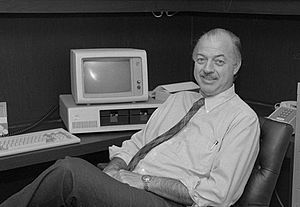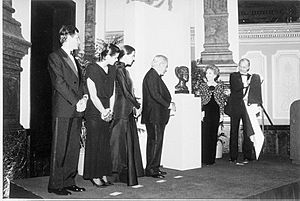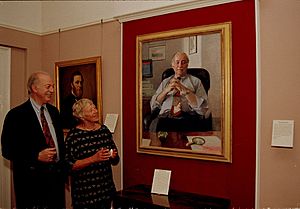Robert McCormick Adams Jr. facts for kids
Quick facts for kids
Robert McCormick Adams Jr.
|
|
|---|---|
 |
|
| 9th Secretary of the Smithsonian Institution | |
| In office 1984–1994 |
|
| Preceded by | S. Dillon Ripley |
| Succeeded by | I. Michael Heyman |
| Director of the Oriental Institute, Chicago | |
| In office 1962–1968 |
|
| Preceded by | Carl Hermann Kraeling |
| Succeeded by | George R. Hughes |
| In office 1981–1983 |
|
| Preceded by | John A. Brinkman |
| Succeeded by | Janet Johnson |
| Personal details | |
| Born | July 23, 1926 Chicago, Illinois, U.S. |
| Died | January 27, 2018 (aged 91) Chula Vista, California, U.S. |
| Nationality | American |
| Education | University of Chicago (BA, MA, PhD) |
| Known for | Research in Iraq Anthropology Archaeology |
| Spouse(s) | Ruth Skinner Adams |
| Awards | Gold Medal Award |
| Scientific career | |
| Fields | Archaeology |
| Thesis | Level and trend in early Sumerian civilization (1956) |
| Doctoral advisor | Robert J. Braidwood |
| Doctoral students | Guillermo Algaze Gregory Possehl Henry T. Wright |
Robert McCormick Adams Jr. (born July 23, 1926 – died January 27, 2018) was an American anthropologist. An anthropologist studies human societies and cultures. He was also the head of the Smithsonian Institution from 1984 to 1994.
Adams did important research in the Near East and Mesoamerica. He was a professor at the University of Chicago for many years. He was especially known for his work studying ancient civilizations in Iraq.
Contents
Early Life and Education
Robert McCormick Adams Jr. was born in Chicago, Illinois. He went to Francis W. Parker School and finished in 1943. He later earned his doctorate degree from the University of Chicago in 1957.
He also worked as a professor at the University of Chicago. He led the Oriental Institute twice. This was from 1962 to 1968 and again from 1981 to 1983. He also served as the provost, a senior leader, at the University of Chicago from 1982 to 1984.
Leading the Smithsonian Institution

Adams became the ninth secretary of the Smithsonian Institution in Washington, D.C. He held this important position from 1984 to 1994. He started his role on September 17, 1984.
As secretary, Adams was in charge of many places. These included thirteen museums, the National Zoo, and research centers. These facilities were in nine states and Panama. He wanted to get the Smithsonian ready for the future.
Key Goals and Projects
Adams focused on making the Smithsonian better for learning. He also wanted to offer more public programs. He worked to include more diverse groups in the Smithsonian's activities.
He oversaw the building of the Quadrangle. This project brought two museums and offices into one large structure. Adams also told the U.S. Congress that many Smithsonian buildings were old. He started fixing up these older places.
These building projects included renovating the Freer Gallery of Art. He also helped build the Mathias Laboratory. This lab is at the Smithsonian Environmental Research Center. Another project was the Earl S. Tupper Research and Conference Center. This center is in Panama.
New Museums and Programs
During Adams's time, the Smithsonian grew even more. It gained the National Museum of the American Indian. The National Postal Museum was also created. This museum shows off a huge collection of stamps.
He helped create the National Science Resources Center. This center works to improve science and math teaching. The International Center was also started. It explores different cultures and supports research in Latin America.
Adams also formed a committee to promote diversity. This committee worked to make the Smithsonian more welcoming to everyone. He encouraged using new technology. For example, the National Air and Space Museum used videodiscs. These stored documents and photos.
Later Life and Achievements
Adams retired from the Smithsonian in 1994 after ten years. He then went back to teaching. He became a professor at the University of California, San Diego.
He continued his work in archaeology and anthropology. He focused on the Middle East. In 1996, he received a Distinguished Service Award. This award was from the Society for American Archaeology.
Archaeological Research and Discoveries
Robert McCormick Adams had a very broad career. He worked in many different fields. He did a lot of fieldwork in the Middle East. He also studied in Mexico.
He used many different subjects in his research. He studied how urban civilizations grew over thousands of years. He also looked at the history of technology. His work in Iraq, Iran, and Saudi Arabia was very important.
Adams believed that social interaction was key. He also thought cultural ecology was important. Cultural ecology looks at how people adapt to their environment. He explored how these things helped civilizations develop. He also studied how different cultures influenced each other.
Based on his digs in Mesopotamia, Adams suggested something important. He said that ancient cities and states did not have just one cause. Instead, they grew from many connected factors. These included how societies were organized and how people specialized in crafts.
Adams was recognized for his important work. He became a member of the American Academy of Arts and Sciences in 1957. In 1970, he joined the United States National Academy of Sciences. He also became a member of the American Philosophical Society in 1974.
In 1988, he received the Golden Plate Award. This was from the American Academy of Achievement. The Archaeological Institute of America gave him the Gold Medal Award in 2002. This was for his great achievements in archaeology.
Works
- The Land Behind Baghdad: A History of Settlement on the Diyala Plains (1965)
- The Evolution of Urban Society: Early Mesopotamia and Prehispanic Mexico (1966)
- The Uruk countryside: The natural setting of urban societies (1972)
- Heartland of Cities:Surveys of Ancient Settlement and Land Use on the Central Floodplain of the Euphrates (1981)
- Science, Ethics, and Food: Papers and Proceedings of a Colloquium Organized by the Smithsonian Institution (Smithsonian International Symposia Series) (1988)
- Paths of Fire: An anthropologist's inquiry into Western technology (1996)
- The Family in America: Searching for Social Harmony in the Industrial Age (2003)
See also
- Martin Harwit


